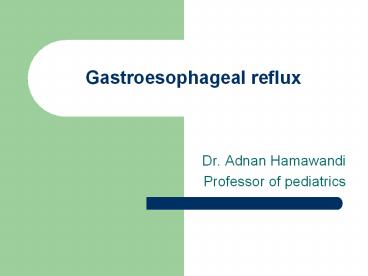Gastroesophageal reflux PowerPoint PPT Presentation
1 / 19
Title: Gastroesophageal reflux
1
Gastroesophageal reflux
- Dr. Adnan Hamawandi
- Professor of pediatrics
2
GER
- This is a common disorder encountered in
pediatric practice. It is considered a
developmental variation in gastrointestinal
motility that resolves as the infant matures. - When GER is unusually severe, persists beyond 18
months of age or is associated with complications
it is considered pathologic GERD and requires
appropriate diagnostic and therapeutic
management.
3
GER- clinical features
- Vomiting may occur immediately or hours after
feeding which is usually effortless and painless,
consisting of small amount of curdled formula.
The vomiting is always - non-bilious and rarely contains blood.
- In the older child a tendency to vomit
easily, heartburn, dysphagia, halitosis, and loss
of dental enamel may occur.
4
GER-Complications
- Persistent GER leads to a number of
complications- - 1. Blood loss and anemia.
- 2. Failure to thrive.
- 3. Peptic esophagitis.
- 4. Esophageal stricture.
- 5. Barrettsesophagus.
- 6. Aspiration pneumonia and bronchoconstriction
.
5
GERD- Diagnosis
- History and physical examination.
- Barium swallow - anatomic abnormalities.
- Overnight PH monitoring for assessing and
quantitating GER. - Esophageal manometry measures resting lower end
esophageal pressure in addition to esophageal
motility. - Endoscopy visualizes mucosa biopsy
6
(No Transcript)
7
GER-Therapy
- Conservative
- 1. Positioning
- 2. Dietary changes.
- Drugs, antacid, H2 receptors antagonist, and
proton pump inhibitors. - Surgery
8
Peptic Ulcer disease
- In children less than 6 years of age ulcers are
found with equal frequencies in boys and girls, a
gastric location as common as duodenal, and a
precipitating factor is common. - In children older than 6 years ulcers are more
frequent in boys and more frequently found in the
duodenum.
9
Peptic ulcer- clinical features
- In neonates, bleeding and perforation are the
usual presentations in association with other
underlying problems like sepsis, asphyxia or
respiratory distress. Older infants and toddlers
frequently vomit and eat poorly. Bleeding is also
common with equal frequency of primary and
secondary ulcers. - In older children pain becomes more important
feature, in addition to bleeding.
10
Peptic ulcer-Diagnosis
- Endoscopic evaluation of the upper
gastrointestinal tract is preferred because of
higher sensitivity in detecting pathology
compared with contrast radiology. In addition
endoscopy allows for tissue biopsy and evaluation
of pattern of inflammation and possible infection
( H.pylori).
11
(No Transcript)
12
Peptic ulcer-Therapy
- If the ulcer is secondary to an underlying
disease, the predisposing factor must be dealt
with properly. - The management of the ulcer itself is directed
against gastric acid either through
neutralization via antiacid or suppression of
secretion via H2 receptor antagonist or proton
pump inhibitors.
13
Peptic ulcer-Therapy
- Sucralfate can be of benefit by binding to the
ulcerated area and possible cytoprotective
properties. - Documented H. pylori infection should be treated.
14
Hypertrophic pyloric stenosis
- Occurs in about 1 in every 500 infant with male
to female ratio of 41. - Symptoms begin between 2 and 4 weeks of age as
projectile non-bilious vomiting. Constipation and
poor weight gain may be observed when the
diagnosis is delayed. After vomiting the infant
is hungry and wants to feed again.
15
Congenital pyloric stenosis
- As the vomiting continues a progressive loss of
fluid, hydrogen ion and chloride leads to
hypochloremic metabolic alkalosis. Serum
potassium levels are usually maintained but there
may be total body potassium depletion.
16
Congenital pyloric stenosis- diagnosis
- Can be established by palpation of the pyloric
mass, a firm, mobile, olive shaped about 2cm in
length best palpated from the left side and
located above and to the right of the umbilicus
in the midepigastrium beneath the liver edge. - If the mass cannot be palpated U/S confirms the
diagnosis in majority of cases.
17
Congenital pyloric stenosis- diagnosis
- Criteria for diagnosis include pyloric mass
thickness gt 4mm or an overall pyloric length
greater than 14mm.
18
Congenital pyloric stenosis- diagnosis
- Barium studies when performed show an elongated
pyloric channel, a bulge of pyloric muscles in
the antrum ( shoulder sign), and parallel streaks
of barium - seen in the narrowed
- channel double tract sign
19
Congenital pyloric stenosis- treatment
- Correction of fluid, acid base and electrolyte
losses with 0.5-0.9 saline in 5-10 glucose with
40meq/L Potassium chloride. - Surgery Ramstedts Pyloromyotomy.

